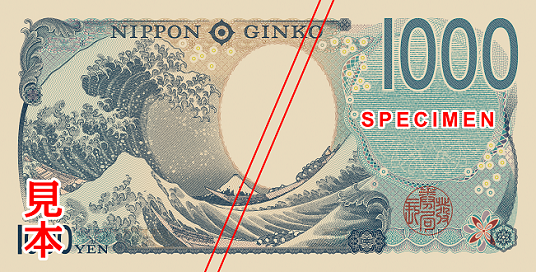
Japanese Banknotes
Society- English
- 日本語
- 简体字
- 繁體字
- Français
- Español
- العربية
- Русский
The National Printing Bureau issued Japan’s first domestically produced banknotes in 1877 and has been responsible for printing the nation’s paper money ever since. There are currently four denominations of banknotes in circulation: ¥10,000, ¥5,000, ¥2,000, and ¥1,000 bills. Around every 20 years, there are major changes to the banknotes’ design; in July 2024, new ¥10,000, ¥5,000, and ¥1,000 notes were introduced.
The NPB delivers 3 billion bills to the Bank of Japan each year. If stacked on top of each other they would tower some 300 kilometers into the sky, or approximately 80 times the height of Mount Fuji. The average lifespan of a ¥10,000 bill is four to five years, while ¥5,000 and ¥1,000 bills tend to last for just one or two years. Badly soiled bills are cut up by the BOJ and recycled into toilet paper and other products.
New Banknotes
Japan’s three new banknotes, issued in July 2024, feature portraits of important figures in the country’s modernization from the late nineteenth century onward. On its reverse, the blue-themed ¥1,000 note also makes use of the iconic Great Wave off Kanagawa artwork by Katsushika Hokusai (1760–1849). Known around the world, Hokusai’s painting shows a huge wave rising in what is now called Tokyo Bay, curving around Mount Fuji in the background.

Sample image of the reverse of the ¥1,000 banknote. (Courtesy of the National Printing Bureau)
Among the three modernizers, businessman Shibusawa Eiichi, who appears on the ¥10,000 banknote, was born in 1840, while Hokusai was still alive. He lived well into the twentieth century, dying in 1931, but was born into the world of the Tokugawa shogunate in the Edo period (1603–1868). His family manufactured and sold indigo dye, while among his many activities, he helped to establish Japan’s modern monetary system and build up the papermaking and printing industries.
The new banknotes also include new anti-counterfeiting and universal design features. Arabic numerals with enlarged fonts make it easier to read the value of each bill, and greater emphasis on the different color themes—brown for the ¥10,000 banknote, purple for the ¥5,000, and blue for the ¥1,000—also helps to distinguish them.
¥10,000
Entrepreneur Shibusawa Eiichi (1840–1931) appears on the obverse of the ¥10,000 bill. After the 1868 Meiji Restoration, he contributed to the modernization of Japan, working to upgrade the monetary system through efforts including the establishment of the First National Bank. Over his lifetime, he was involved in the establishment of some 500 corporations, and became known as “the father of capitalism” in Japan. The bill’s reverse depicts Tokyo Station, a red-brick landmark built in 1914.

(Courtesy of the National Printing Bureau)
¥5,000
Tsuda Umeko (1864–1929), known for her contributions to women’s education, is the face of the ¥5,000 bill. At the age of six, she became one of Japan’s first female overseas students after traveling to the United States as part of the Iwakura Mission. Among her many activities promoting women’s education, she founded an educational institution for women that later became Tsuda University. The bill’s reverse has an illustration of wisteria flowers, which have long been appreciated in Japanese art and literature.

(Courtesy of the National Printing Bureau)
¥1,000
The obverse of the ¥1,000 bill features the bacteriologist Kitasato Shibasaburō (1853–1931). He studied in Germany from 1885 to 1892, working under Robert Koch (1843–1910). He discovered the tetanus and plague bacilli, developing a treatment method for the former, and founded institutes for tackling infectious diseases. Hokusai’s Great Wave off Kanagawa, which appears on the reverse, is his best-known work in an oeuvre that influenced artists around the world.

(Courtesy of the National Printing Bureau)
New Anti-Counterfeiting Measures
One reason for introducing new banknotes is to improve anti-counterfeiting technology. The new bills feature the world’s first three-dimensional holograms that make the portraits appear to rotate when tilted.
(Courtesy of the National Printing Bureau)
Previously Issued Banknotes
¥10,000
Thinker and educator Fukuzawa Yukichi (1835–1901), the founder of Keiō University who played a leading role in the modernization of Japan, appears on the obverse of the ¥10,000 bill printed from 2004 to 2024; the portrait for this bill remained unchanged from the 1984 issue. The bill’s reverse depicts a statue of the mythological hōō bird, which portends good fortune, found in the Hōōdō hall at the ancient temple Byōdōin in Uji, Kyoto.

(Courtesy of the National Printing Bureau)
¥5,000
The obverse of the ¥5,000 bill from 2004 to 2024 features the novelist Higuchi Ichiyō (1872–96), a pioneer of modern Japanese fiction. The bill’s reverse shows a detail from the Kakitsubatazu (Irises) folding screens by the artist Ogata Kōrin (1658–1716).

(Courtesy of the National Printing Bureau)
¥1,000
The obverse of the ¥1,000 bill from 2004 to 2024 has a portrait of doctor and bacteriologist Noguchi Hideyo (1876–1928). He is known for his study of diseases including yellow fever and syphilis. The reverse is a rendering of Mount Fuji and cherry blossoms at Lake Motosu in Yamanashi Prefecture.

(Courtesy of the National Printing Bureau)
¥2,000
The obverse of the relatively rare ¥2,000 bill, issued in 2000, shows the Shureimon gate at Shuri Castle in Naha, Okinawa. The bottom right corner of the reverse depicts the author Murasaki Shikibu, while to the left is a scene from her masterpiece, The Tale of Genji.

(Courtesy of the National Printing Bureau)
(Translated from Japanese. Banner photo: The obverse of the new banknotes. Courtesy National Printing Bureau. All images and videos courtesy National Printing Bureau.)
